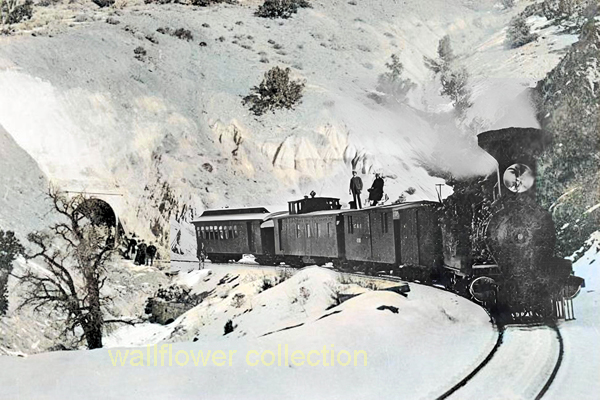https://mojavedesert.net/railroads/carson-and-colorado
The Carson and Colorado Railway, initially incorporated on May 10, 1880, was a critical artery in the economic development of Nevada and Eastern California. Running approximately 300 miles from Mound House, Nevada, to Keeler, California, this narrow-gauge railway navigated some of the region’s most challenging terrains, including the formidable 7,100-foot-high Montgomery Pass.

Carson & Colorado at Mt. Montgomery Pass – 1882
Early Days and Expansion
Construction of the railway began swiftly after its incorporation, aiming to connect the isolated mining and agricultural communities along its route. Operations commenced on August 1, 1883, with the railway serving as a vital transport link for ore, goods, and passengers. The line initially facilitated the economic boom in mining areas, particularly with the discovery of silver and gold in Tonopah and Goldfield, Nevada.
Technical Specifications
The railway was built as a narrow gauge (3 feet or 914 mm), which was more economical and could handle the sharp curves and steep grades of the mountainous regions better than standard gauges. It used a variety of steam locomotives suitable for the narrow gauge and the challenging conditions of the route. These trains were crucial for transporting diverse freight, including timber, livestock, and minerals, and also provided passenger services essential for local populations’ mobility.
Strategic Reorganizations
In 1892, the railway was reorganized as the Carson and Colorado Railway. In 1900, it was sold to the Southern Pacific Company, marking a significant transition in its operations. This acquisition integrated the Carson and Colorado into a larger railway network, enhancing its operational capacity through better resources and management. The northern section from Mound House to Mina was converted to standard gauge in 1905, facilitating direct interchange with other lines and improving logistical efficiency.
Decline and Legacy
Despite its importance, the railway’s relevance waned with the rise of automobiles and improved road networks. The railway began phasing out operations, with parts of the line abandoned in the 1930s and 1940s. The last train ran on April 29, 1960, and the tracks were removed in January 1961.
Today, the legacy of the Carson and Colorado Railway is preserved in museums and historical sites along the former route. These sites celebrate its role in the development of the American West, particularly in how it supported remote communities and contributed to the region’s economic dynamism.
Community Impact
The presence of the railway significantly shaped communities like Mound House, Hawthorne, Bishop, and Laws. The railway not only supported local economies but also fostered their growth by connecting them to larger markets and other parts of the country. The connection at Mound House with the Virginia and Truckee Railroad was particularly crucial, enhancing the flow of goods and ores from Nevada’s mining districts to broader markets.
The Carson and Colorado Railway remains a topic of interest for historians and railway enthusiasts. It symbolizes the challenges and triumphs of maintaining railway service in one of America’s most rugged landscapes.
This article provides a comprehensive look at the historical and technical aspects of the Carson and Colorado Railway, illustrating its importance in the development and eventual decline of regional rail transport in the American West.